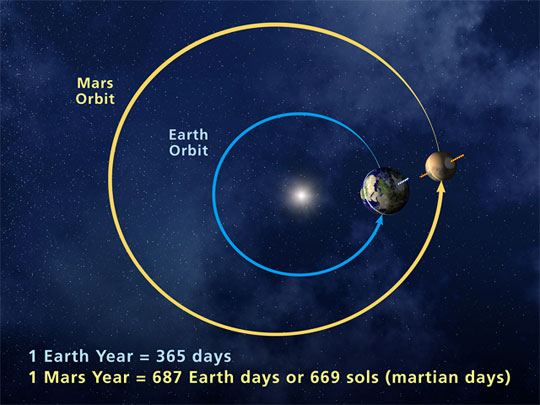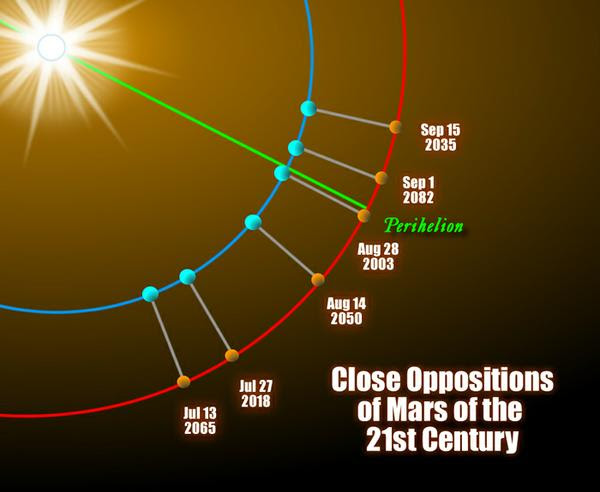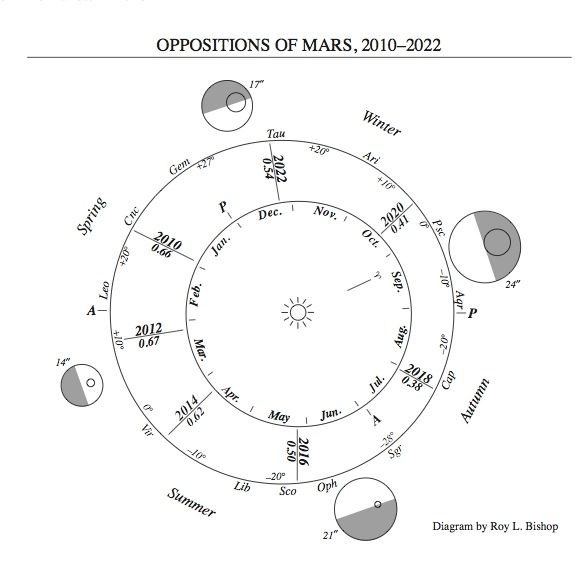Mars on July 14, 2018, from Johnnyxbox Childers. You can see Mars easily now. It’s very bright and very red. East each evening, west before dawn.
Mars comes closest to Earth every other year, around the time of its opposition, when Earth is sweeping between the sun and Mars. Mars was at opposition on July 27, 2018, and – at this very favorable opposition – Mars was also be at its brightest since 2003. Yet Mars is closest to us several days after opposition, during the night of July 30 (morning of July 31) according to clocks in North America.
Why are the dates different? Why was Mars brightest then, although it is closest now? And is now a good time to view Mars through a telescope? For the answers to all of those questions, read this post: Mars closest to Earth on July 30-31.
Want to know more about the cycle of close and far Mars oppositions? Keep reading …

Artist’s concept of the Mars opposition, when Earth is sweeping between the sun and Mars, via NASA.

Extra-close oppositions of Mars happen every 15 to 17 years, when we pass between Mars and the sun around the time of its perihelion (closest point to the sun in orbit). Illustration via ClassicalAstronomy.com.
Oppositions of Mars are far from equal, and this one is a good one. At its closest – July 30-31, 2018 – Mars comes to within 35.78 million miles (57.59 million km) of Earth.
Nearly 60,000 years ago – on September 24, 57,617 B.C. – Mars was only 34.62 million miles (55.72 million km) distant. That historic close opposition was closest in living memory, although the opposition of Mars on August 28, 2003 – which brought Mars to 34.65 million miles (55.76 million km) of Earth – was Mars’ closest approach since the Stone Age. The record for closeness set in 2003 won’t be broken again until August 29, 2287.
In contrast, the most recent distant opposition of Mars – on March 3, 2012 – placed the planet at 62.62 million miles (100.78 million km) away.
Mars comes closest to Earth about every two years. Earth takes a year to orbit the sun, and Mars takes about two years. So we go between the sun and Mars – bringing Mars closest to us for that two-year period – that often. But Mars is especially close in 2018. The illustration below shows why:

This diagram by Roy L. Bishop shows you the separation between Mars and Earth at recent oppositions. The separation of the 2 planets is expressed in astronomical units, or AU (one AU equals one Earth-sun distance) and is indicated beside each of the connecting lines at the various oppositions. Copyright Royal Astronomical Society of Canada. Used with permission. Visit the RASC estore to purchase the Observer’s Handbook, a necessary tool for all skywatchers. Read more about this image.
Mars is close in 2018 because its perihelion or closest point to the sun is coming up on September 16, 2018. Earth has a closest and farthest point from the sun, too. We’re closest to the sun every January, and farthest from the sun every July. But the orbit of Earth is very nearly circular, so our distance from the sun doesn’t vary much (only about 3 million miles, or 5 million km). Because Mars’ orbit is more highly elliptical, Mars’ distance from the sun varies more (by about 26 million miles, or 43 million km).
Perhaps you can see that – when Mars is closer to the sun around the time we pass between it and the sun – it’s closer than usual to us.
Astronomers call this year’s opposition of Mars a perihelic opposition. The last one was in 2003.
View larger. | What makes this 2018 Mars opposition special – and the reason Mars is so bright now – is that we go between the sun and Mars around the time Mars is closest to the sun (perihelion). Image via Guy Ottewell.
Close (or distant) oppositions of Mars recur in periods of 15 to 17 years. Note that we’re now 15 years past the historically close encounter on August 28, 2003.
Mars’ next extra-close opposition will be September 15, 2035, though – like the 2018 opposition – it won’t be quite as close as the opposition of August, 2003.
Very similar Martian oppositions take place every 79 years (15 + 17 + 15 + 17 + 15 = 79). These 79-year cycles repeat with only a delay of two to five calendar days. The super-close opposition of Mars in the year 2082 will fall on September 1, 2082. But once again, Earth and Mars won’t come as close as they did in August 2003.
There is a more exact cycle of 284 years (79 + 79 + 79 + 15 + 17 + 15 = 284). The Martian opposition that comes 284 years after August 28, 2003 will fall on August 29, 2287. This time around, Mars will come closer to Earth than it did during its close encounter in August 2003.
Look for Mars tonight! It’ll be bright through about early September, 2018. You won’t see Mars this size again until 2035. Illustration via nasa.tumblr.com.
Because the Martian orbit is becoming more eccentric (flatter), the closest oppositions will actually come closer to Earth, and the farthest oppositions will actually become more distant. The computational wizard Jean Meeus figures that from the years 0 to 3000 A.D., Mars will come closest to Earth on September 8, 2729 (55.65 million kilometers) and farthest away on March 6, 2832 (101.50 million kilometers).
Want to know more about close and far Martian oppositions? Click here.
While the time is at hand, enjoy the close appearance of Mars in Earth’s sky during July and August of 2018.
View larger. | Mars’ path across Earth’s sky in 2018, via Guy Ottewell. You can learn to follow the planets in the night sky using EarthSky’s monthly planet guide.
Bottom line: Oppositions of Mars are far from equal. This post explains why Mars has near and far oppositions and shows why the 2018 opposition is a particularly good one.
from EarthSky https://ift.tt/2twixdw
Mars on July 14, 2018, from Johnnyxbox Childers. You can see Mars easily now. It’s very bright and very red. East each evening, west before dawn.
Mars comes closest to Earth every other year, around the time of its opposition, when Earth is sweeping between the sun and Mars. Mars was at opposition on July 27, 2018, and – at this very favorable opposition – Mars was also be at its brightest since 2003. Yet Mars is closest to us several days after opposition, during the night of July 30 (morning of July 31) according to clocks in North America.
Why are the dates different? Why was Mars brightest then, although it is closest now? And is now a good time to view Mars through a telescope? For the answers to all of those questions, read this post: Mars closest to Earth on July 30-31.
Want to know more about the cycle of close and far Mars oppositions? Keep reading …

Artist’s concept of the Mars opposition, when Earth is sweeping between the sun and Mars, via NASA.

Extra-close oppositions of Mars happen every 15 to 17 years, when we pass between Mars and the sun around the time of its perihelion (closest point to the sun in orbit). Illustration via ClassicalAstronomy.com.
Oppositions of Mars are far from equal, and this one is a good one. At its closest – July 30-31, 2018 – Mars comes to within 35.78 million miles (57.59 million km) of Earth.
Nearly 60,000 years ago – on September 24, 57,617 B.C. – Mars was only 34.62 million miles (55.72 million km) distant. That historic close opposition was closest in living memory, although the opposition of Mars on August 28, 2003 – which brought Mars to 34.65 million miles (55.76 million km) of Earth – was Mars’ closest approach since the Stone Age. The record for closeness set in 2003 won’t be broken again until August 29, 2287.
In contrast, the most recent distant opposition of Mars – on March 3, 2012 – placed the planet at 62.62 million miles (100.78 million km) away.
Mars comes closest to Earth about every two years. Earth takes a year to orbit the sun, and Mars takes about two years. So we go between the sun and Mars – bringing Mars closest to us for that two-year period – that often. But Mars is especially close in 2018. The illustration below shows why:

This diagram by Roy L. Bishop shows you the separation between Mars and Earth at recent oppositions. The separation of the 2 planets is expressed in astronomical units, or AU (one AU equals one Earth-sun distance) and is indicated beside each of the connecting lines at the various oppositions. Copyright Royal Astronomical Society of Canada. Used with permission. Visit the RASC estore to purchase the Observer’s Handbook, a necessary tool for all skywatchers. Read more about this image.
Mars is close in 2018 because its perihelion or closest point to the sun is coming up on September 16, 2018. Earth has a closest and farthest point from the sun, too. We’re closest to the sun every January, and farthest from the sun every July. But the orbit of Earth is very nearly circular, so our distance from the sun doesn’t vary much (only about 3 million miles, or 5 million km). Because Mars’ orbit is more highly elliptical, Mars’ distance from the sun varies more (by about 26 million miles, or 43 million km).
Perhaps you can see that – when Mars is closer to the sun around the time we pass between it and the sun – it’s closer than usual to us.
Astronomers call this year’s opposition of Mars a perihelic opposition. The last one was in 2003.
View larger. | What makes this 2018 Mars opposition special – and the reason Mars is so bright now – is that we go between the sun and Mars around the time Mars is closest to the sun (perihelion). Image via Guy Ottewell.
Close (or distant) oppositions of Mars recur in periods of 15 to 17 years. Note that we’re now 15 years past the historically close encounter on August 28, 2003.
Mars’ next extra-close opposition will be September 15, 2035, though – like the 2018 opposition – it won’t be quite as close as the opposition of August, 2003.
Very similar Martian oppositions take place every 79 years (15 + 17 + 15 + 17 + 15 = 79). These 79-year cycles repeat with only a delay of two to five calendar days. The super-close opposition of Mars in the year 2082 will fall on September 1, 2082. But once again, Earth and Mars won’t come as close as they did in August 2003.
There is a more exact cycle of 284 years (79 + 79 + 79 + 15 + 17 + 15 = 284). The Martian opposition that comes 284 years after August 28, 2003 will fall on August 29, 2287. This time around, Mars will come closer to Earth than it did during its close encounter in August 2003.
Look for Mars tonight! It’ll be bright through about early September, 2018. You won’t see Mars this size again until 2035. Illustration via nasa.tumblr.com.
Because the Martian orbit is becoming more eccentric (flatter), the closest oppositions will actually come closer to Earth, and the farthest oppositions will actually become more distant. The computational wizard Jean Meeus figures that from the years 0 to 3000 A.D., Mars will come closest to Earth on September 8, 2729 (55.65 million kilometers) and farthest away on March 6, 2832 (101.50 million kilometers).
Want to know more about close and far Martian oppositions? Click here.
While the time is at hand, enjoy the close appearance of Mars in Earth’s sky during July and August of 2018.
View larger. | Mars’ path across Earth’s sky in 2018, via Guy Ottewell. You can learn to follow the planets in the night sky using EarthSky’s monthly planet guide.
Bottom line: Oppositions of Mars are far from equal. This post explains why Mars has near and far oppositions and shows why the 2018 opposition is a particularly good one.
from EarthSky https://ift.tt/2twixdw

Aucun commentaire:
Enregistrer un commentaire